Includes free printable chore chart for kids and a great way to motivate kids to pitch in with weekly chores. Learn how it helped my 8 and 5 year olds get excited about a chore system.
It became clear on a recent family vacation that my daughter was, to be honest, as independent as a newborn koala bear tucked warm and snug in her mother’s pouch.
At age 6, she prefers to be carried constantly. She would shout out loud and demanding requests for things she can do on her own, ex: “Water in a red cup, please!” And even when it was time to get dressed or put on her shoes she would tell us that it was “just easier” if we did it for her.
She was right. Overtime, it had just become “just easier” for me to do these things instead of teaching her to do them. I realized I was only hurting her by having this mindset. My husband and I created the tiniest, most helpless and demanding, yet adorable, creature.
When we did try to enforce chores or tasks, she would tell us how much she hated doing whatever we asked of her.
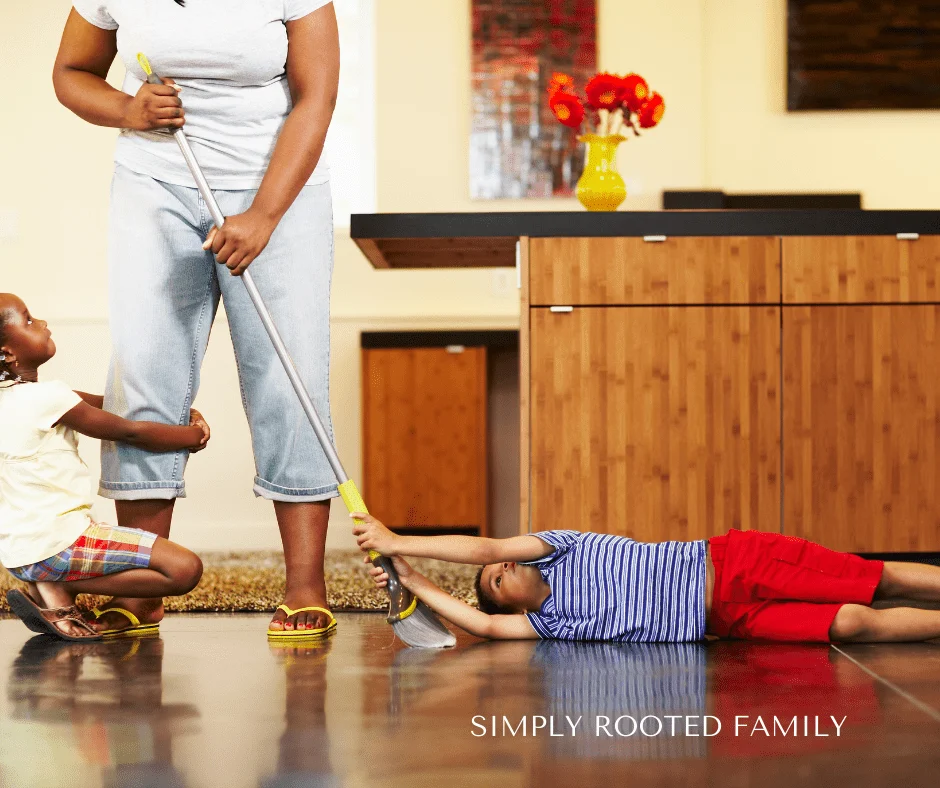
Our older son, on other hand, at age 10, is fairly independent. When he wakes up each morning he brushes his teeth, picks out an outfit, and pours himself a bowl of cereal.
We still decided that all three of our children could benefit from becoming a little more independent and learning to do more basic skills at an early age.
But how do you initiate chores in a kid who hasn’t really done them in the past or who passionately hates doing them?
Looking for a printable cleaning checklist for your family? Start here!
Have Realistic Expectations About Household Chores
Like any new family routine, it will only work if you take a realistic approach.
First, your goal shouldn’t be to raise kids who look forward to scrubbing toilets. And expecting your floors to sparkle after your kid’s first go-around will set you up for failure.
Instead, the goal of a family chore chart is to instill independence in your kids by teaching them basic life skills. You want them to have a sense of family and understand the value of responsibility.
Kids who do chores develop strong family roots.
In fact, the American Association of Child and Adolescent Psychiatry explains that benefits of chores are seen in children as early as 3 years of age.
Research also suggests that children who do chores have higher self-esteem, are more responsible, and are better equipped to deal with frustration. Additionally, these skills can lead to greater success in school, work, and even relationships.

No matter what chores you select, follow these 5 simple tips for success.
Related: 5 Life Skills to Teach All Kids
Getting Started with a Chore Plan
Before initiating household tasks, it is important to have open communication with your children about these new expectations.
Do these 5 things first:
1) Set Clear Expectations
Make sure your children clearly understand what you are going to be requesting.
Sit down and have a quick family meeting to discuss the changes that you expect to happen at home.
Whether you start a chore list, or give them advanced notice, such as “After dinner, you will put your dishes in the sink”, it will help establish a foundation.
For example, we developed this action plan that went along with our summer chore charts:
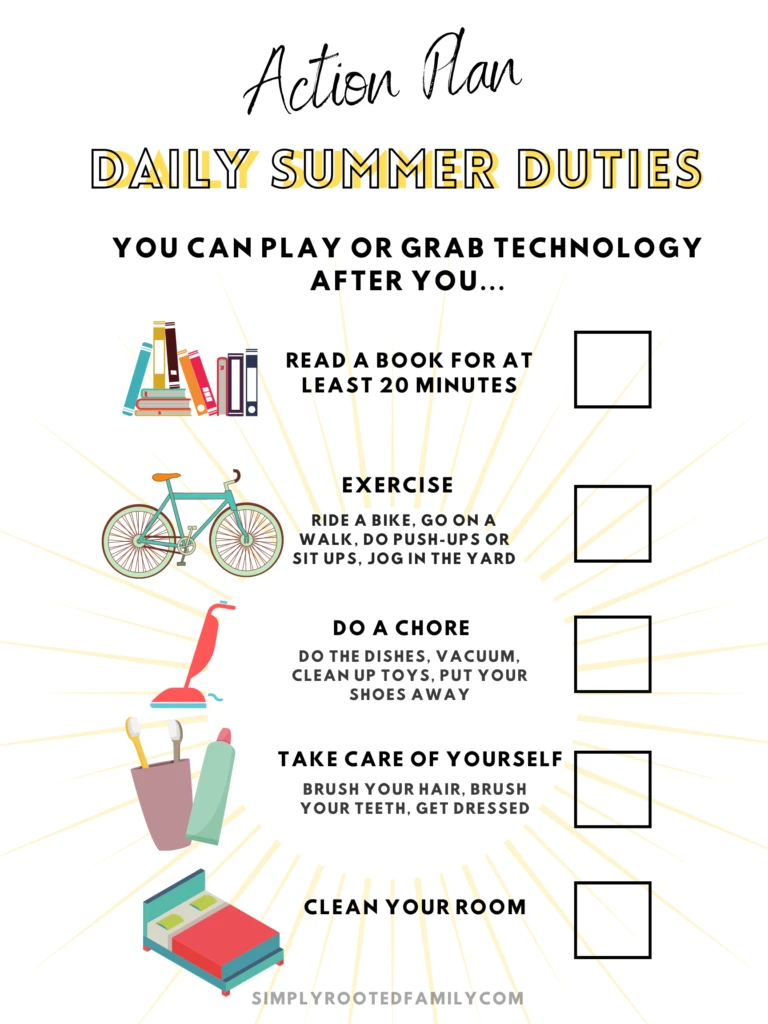
With this plan, the kids knew that they had to take care of their responsibilities before having screen time or free time.
Related: How to Motivate Lazy Kids
2) Be a role model
Kids will understand their responsibilities better if they see other people in the family doing them.
Every family member (yes, the whole family) should pitch in, even older kids who think a chore list sounds silly, they must participate.
3) Give Positive Feedback
My daughter hated chores, but she loved to be praised. When we learned that, it became easily to give her positive reinforcement.
They should not be offered a reward each time they clean up their toys; however, you can let them know that they are doing something positive with a chore chart or even a simple “Good job!”
My children would get a check on the below chore chart when they finished a task, and after a certain amount of checks they could pick out a small reward.
You may also like: How to Coach Kids to be Genuinely Respectful
4) Be consistent
With any new daily routine, consistency is key.
Tie the daily chores to a simple activity, such as making their bed when they wake up. After a few times it will become a regular habit.
We use a rotating weekly responsibility chart. Download your free copies here:

5) Keep the tasks age-appropriate
Make sure that tasks for young children are simple, basic chores. This will eliminate stress, and it will encourage them to help out.

Age-Appropriate Chore Ideas and Respons
Grow your child’s independence and expand their life skills with these specific tasks (depending on their age groups and abilities).
Little Kids: Age 3 through 5 years old
My 3 year old son loves to do things on his own. You see him light up even if he is given simple tasks.
Some responsibilities for younger kids can include:
- Putting their dish in the sink after dinner
- Cleaning up their toys on their own
- Giving them distance when playing (outside/at a park, etc), let them climb and do risky things
Toddler chores can even include helping out with whatever you are doing. Let them sweep with you or help gather matching socks while you are doing the laundry.
Older Kids: Age 5 through 7 years old
From my experience, as my kids get older, they sometimes need a little push to be more socially independent. For example, we started having my children tell the waiter/waitress what they are ordering at a restaurant, instead of ordering for them.
Some other responsibilities can include:
- Preparing their own meal, if it is appropriate (ex; sandwiches)
- Make their bed
- Hand money to clerk when purchasing something
- Learn to buckle car seat
- Learn to tie shoes
- Get a drink by themselves
- Putting their laundry in their room
We also encourage our children to play while being “lightly-supervised”. By “lightly-supervised” I mean that we are watching our children to make sure that they are safe; however, we let them work out their own small issues and we do not hover over them.
Helping out with pets at home is a great way to teach kids responsibility. Do you have a dog? Encourage your child to help out with this pet dog chore chart.
Pre-teens and Older Children : Ages 8 and above
My 7 year old’s favorite responsibility is when we tell him that we are leaving the room and he is “babysitting” his siblings. He takes this role very seriously, and glows with pride.

Related: Negative Effects that Helicopter Parenting has on Kids
Some responsibilities can include:
- Walk to a local friend’s house or take pet on a walk (of course depending on child, neighborhood, safety concerns)
- Vacuum their room
- Fold Laundry
- Water plants
- Load the dishwasher
- Pour their own cereal
Here are simple chore chart ideas:
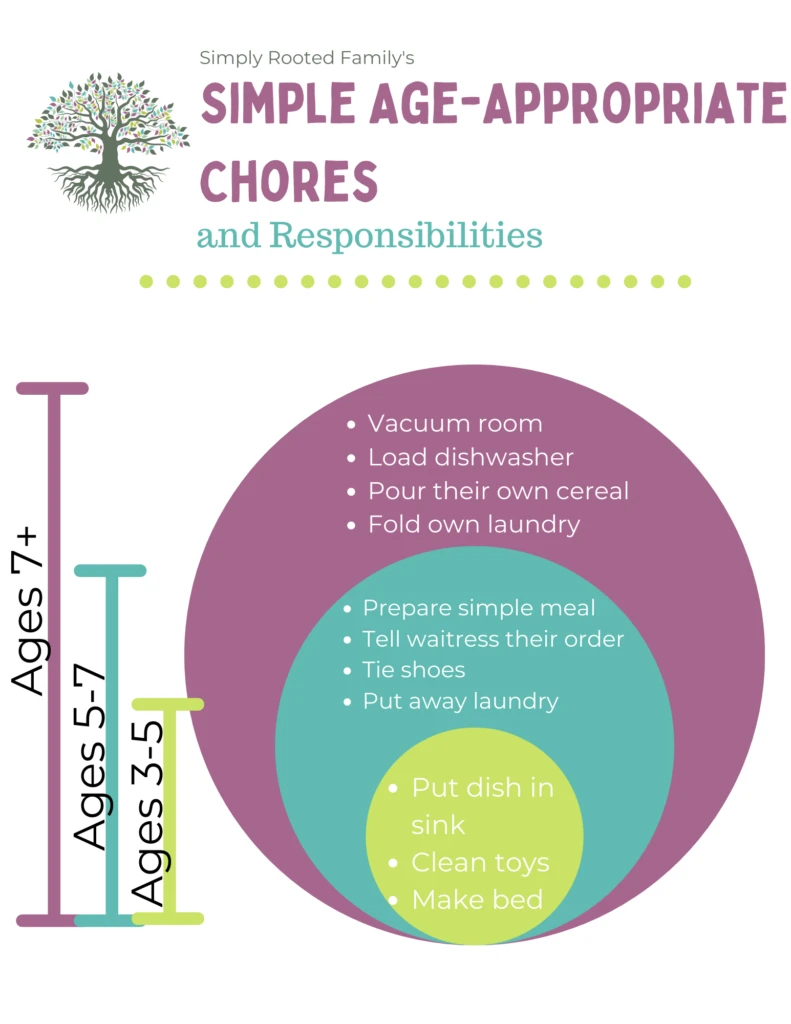
Encouragement with Chore Charts
I didn’t want to offer “rewards” every time my kids pitched in around the home. However, I found that the moment I put up a chore chart they were excited to work for each check on that list.
Your reward system is totally up to you and what it best for your entire family. When my children were little, it was simply a trip to get ice cream. As they got older, we started a small allowance (which also taught them the value of money).
After a while, helping out around the house became more of a habit. I couldn’t believe the impact that this simple chore chart had on my kids.
Everytime they did a chore, they received a check on the list. When they made it to a balloon column, then they received a dollar. My daughter even started asked for extra chores.
Print this free chore chart for your family, and subscribe for access to all of our free printables:
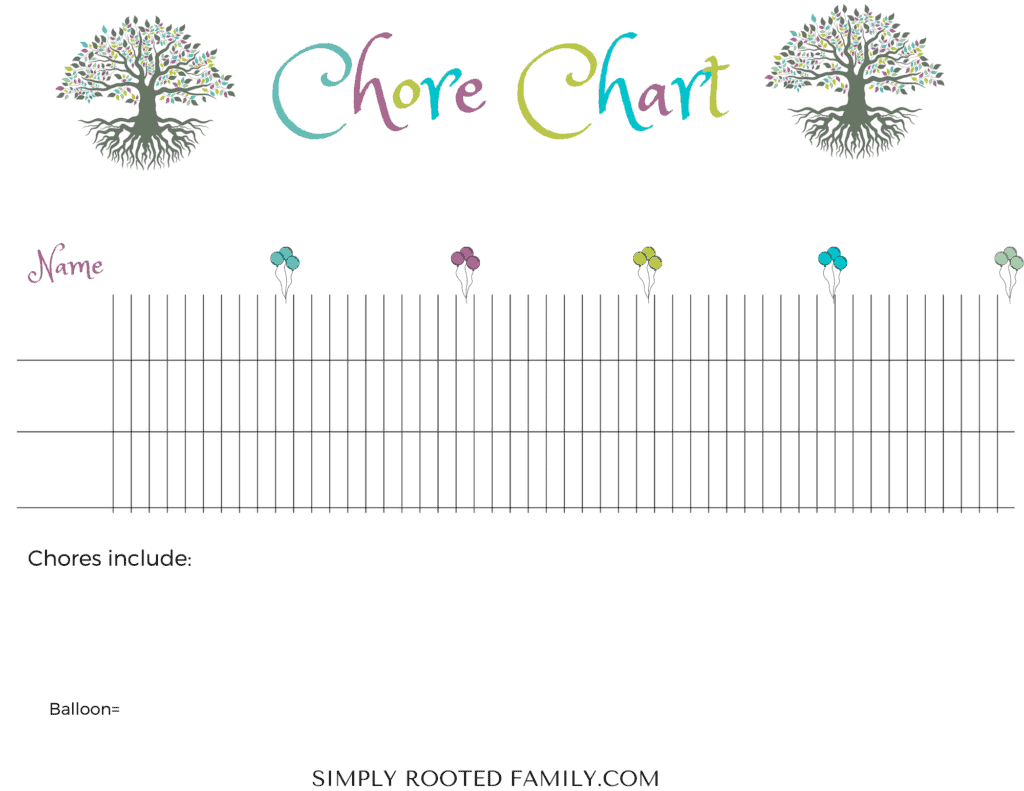
Final Thoughts on Chore Charts for Kids
Although this may be common sense to some parents, teaching your kids life skills and giving them responsibilities will have a 2-fold effect. First, your child’s confidence will soar. When they complete a task or succeed in an age-related duty, it builds work ethic, which is a big deal.
Secondly, these tasks will gradually start to come off of your plate. It is a huge help to parents when children start to lend a hand.
As soon as we started to implement these simple chore and the , my tiny baby koala started to climb out of my pouch and grow in this big, bright world.
For list of chores and weekly chore chart for family click here.
And follow us on Facebook here for more updates.

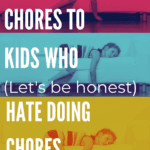
3 Facts that Decode the Boy Brain and Lead to Better Bonding and Parenting - Simply Rooted Family
Wednesday 19th of October 2022
[…] example, a chore checklist or routine chart can help motivate him and guide him to feel excited and proud of […]
Raise Kids who Lift up Other Kids, Not Put Them Down - Simply Rooted Family
Monday 11th of April 2022
[…] here for age-appropriate chores and a free, printable chore […]
Damage Control Plan for How to Deal with an Ungrateful Child - Simply Rooted Family
Thursday 7th of April 2022
[…] here for simple ways to introduce chores to kids – including age-appropriate chore […]
5 Life Skills to Teach All Kids Before They are Teens - Simply Rooted Family
Wednesday 6th of April 2022
[…] Related: Age-appropriate Chores for Kids […]
5 Ways Your Kid is Telling You That You're Too Strict of a Parent - Simply Rooted Family
Wednesday 6th of April 2022
[…] expectations – age appropriate chores, being kind to family […]